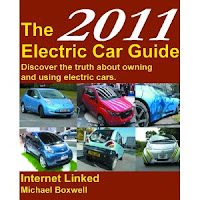As the world focuses on the threat that oil poses to energy security, climate change once again fell off the pages of the world's media. Until yesterday. Oh, and today.
According to the IEA (International Energy Agency), in 2010 greenhouse gas emissions increased by a record amount, to the highest carbon output in history.
Apparently, the most serious global recession for 80 years had only a minimal effect on emissions. According to the Guardian newspaper's report, last year, a record 30.6 gigatonnes of carbon dioxide poured into the atmosphere, mainly from burning fossil fuel – a rise of 1.6Gt on 2009. Most of the rise – about three-quarters – came from developing countries, as rapidly emerging economies weathered the financial crisis and the recession that gripped most of the developed world.
The IEA has calculated that if the world is to escape the most damaging effects of global warming, annual energy-related emissions should be no more than 32Gt by 2020. If this year's emissions rise by as much as they did in 2010, that limit will be exceeded nine years ahead of schedule, making it all but impossible to hold warming to a manageable degree.
While the emissions data is bad enough news, there are other factors that make it even less likely that the world will meet its greenhouse gas targets.
• About 80% of the power stations likely to be in use in 2020 are either already built or under construction. Most of these are fossil fuel power stations unlikely to be taken out of service early, so they will continue to pour out carbon – possibly into the mid-century. The emissions from these stations amount to about 11.2Gt, out of a total of 13.7Gt from the electricity sector. These "locked-in" emissions mean savings must be found elsewhere.
• Following the tsunami damage at Fukushima, Japan and Germany have called a halt to their reactor programmes, and other countries are reconsidering nuclear power.
• UN negotiations on a new global treaty on climate change have stalled.
Other news: an irreversible climate "tipping point" could occur within the next 20 years as a result of the release of huge quantities of organic carbon locked away as frozen plant matter in the vast permafrost region of the Arctic, according to a study published today by the US National Snow and Ice Data Centre in Boulder, Colorado.
This stuff is scary.
Other news: an irreversible climate "tipping point" could occur within the next 20 years as a result of the release of huge quantities of organic carbon locked away as frozen plant matter in the vast permafrost region of the Arctic, according to a study published today by the US National Snow and Ice Data Centre in Boulder, Colorado.
This stuff is scary.
Much of the growth of emissions is due to the sheer increase in the number of cars on the road. It is clear now more than ever before that we need to get to real 'zero emission' vehicles quickly. This means we need to transition entirely away from the internal combustion engine and into electric vehicles charged by electricity from renewable energy sources (and probably in the interim period nuclear as well).
The EU has set a target of 60% of all new car sales being electric by 2030 and 100% by 2050. This target already looks too conservative. To have meaning, it also needs to be tied strongly to targets for the proportion of electricity generated by renewable energy sources. Here, the IPCC has set a global target of 77% by 2050. What is needed is a clear energy and transport policy with linked goals and programmes at both the global and the national level.
It is time for the politicians and auto manufacturers to step up to the plate and add their voices so that there can be no doubt whatsoever of our direction. Let's end oil.
'End oil' means stop developing plug-in hybrids, not just conventionally fuelled cars. It is only delaying the solution we need and diverting funds from pure EV development.
Forget 'range anxiety', vehicles with increased range and fast charging are on their way. Just as computers and mobile phones developed rapidly, so too will the performance of EVs.
The Renault Zoe to be launched in Europe next year will offer a range in excess of 200 km / 125 miles per charge, BMW are aiming for 160 miles for their i3, and lab testing indicates 350 mile range will be affordable and practical within 5 years. With fast charging you can double these numbers for a daily range, effectively ending the debate over range anxiety.
'End oil' means stop developing plug-in hybrids, not just conventionally fuelled cars. It is only delaying the solution we need and diverting funds from pure EV development.
Forget 'range anxiety', vehicles with increased range and fast charging are on their way. Just as computers and mobile phones developed rapidly, so too will the performance of EVs.
The Renault Zoe to be launched in Europe next year will offer a range in excess of 200 km / 125 miles per charge, BMW are aiming for 160 miles for their i3, and lab testing indicates 350 mile range will be affordable and practical within 5 years. With fast charging you can double these numbers for a daily range, effectively ending the debate over range anxiety.












